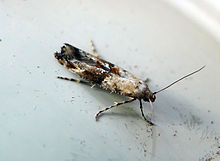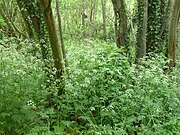-
Habitat, Ireland
-
Larva (with frass)
-
Pupa in an open network cocoon
| Epermenia chaerophyllella | |
|---|---|

| |
|
Scientific classification
| |
| Domain: | Eukaryota |
| Kingdom: | Animalia |
| Phylum: | Arthropoda |
| Class: | Insecta |
| Order: | Lepidoptera |
| Family: | Epermeniidae |
| Genus: | Epermenia |
| Species: | E. chaerophyllella
|
| Binomial name | |
| Epermenia chaerophyllella (
Goeze, 1783)
| |
| Synonyms | |
| |
Epermenia chaerophyllella, also known as the garden lance-wing, is a moth of the family Epermeniidae first described by Johann August Ephraim Goeze in 1783. It is found in all of Europe and Asia Minor. [1] [2]
Moths can be found in all months of the year. They are most abundant from October to May and in July and August. [3] The wingspan is 12–14 mm. Adults are blackish, chestnut and whitish. There are two to three generations per year with the last generation of adults overwintering. [4] Epermenia aequidentellus looks similar, but has narrower forewings without a hooked apex. [5]
Eggs are laid between April and September on the underside of a mature leaf of a plant from the Umbelliferae family, often near the edge. [3]
Larvae can be found from May to June and again from August to September. [6] The body sometimes appear translucent and can be glossy white, yellow or greenish, with black or brown spots and a whitish dorsal line. The head is pale brown. There are five instars. [3] Larva of Epermenia aequidentellus found on wild carrot ( Daucus carota) have a dark dorsal line and a black head. [4]
The larvae feed on various Apiaceae species, including ground elder ( Aegopodium podagraria), garden angelica ( Angelica archangelica litoralis), angelica ( Angelica sylvestris), bur-chervil ( Anthriscus caucalis), chervil ( Anthriscus cerefolium), cow parsley ( Anthriscus sylvestris), celery ( Apium graveolens), lesser water-parsnip ( Berula erecta), caraway ( Carum carvi), Chaerophyllum hirsutum, rough chervil ( Chaerophyllum temulum), cowbane ( Cicuta virosa), hemlock ( Conium maculatum), wild carrot ( Daucus carota), giant hogweed ( Heracleum mantegazzianum), hogweed ( Heracleum sphondylium), lovage ( Levisticum officinale), water dropwort ( Oenanthe species), parsnip ( Pastinaca sativa), Peucedanum species, burnet-saxifrage ( Pimpinella saxifraga), moon carrot ( Seseli libanotis), Silaum species, Sison amomum, [7] great water-parsnip ( Sium latifolium) and hedge parsleys ( Torilis species). [6]
- Pupa
The light brown pupa is in an open network cocoon and is normally found in detritus on the ground or occasionally on the leaf, or in a petiole groove. [3]
- ^ "Epermenia (Calotripis) chaerophyllella (Goeze, 1783)". Fauna Europaea. Retrieved 3 October 2020.
- ^ Savela, Markku Savela. "Epermenia Hübner, [1825]". Lepidoptera and some other life forms. Retrieved 3 October 2020.
- ^ a b c d Godfray, H C J; Sterling, P H (1996). Epermeniidae. In Moths and Butterflies of Great Britain and Ireland. Volume 3. Colchester: Harley Books. pp. 121–2. ISBN 0-946589-56-9.
- ^ a b Kimber, Ian. "Epermenia chaerophyllella (Goeze, 1783)". UKmoths. Retrieved 3 October 2020.
- ^ Sterling, Phil; Parsons, Mark; Lewington, Richard (2012). Field Guide to the Micromoths of Great Britain and Ireland. Gillingham, Dorset: British Wildlife Publishing. p. 201. ISBN 978-0-9564902-1-6.
- ^ a b Ellis, W N. "Epermenia chaerophyllella (Goeze, 1783) garden lance-wing". Plant Parasites of Europe. Retrieved 3 October 2020.
- ^ Dr. Willem N. Ellis (2013-03-15). "Sison amomum, stone parsley". bladmineerders.nl. Dr. Willem N. Ellis, Amsterdam, the Netherlands. Retrieved 2013-03-15.
| Epermenia chaerophyllella | |
|---|---|

| |
|
Scientific classification
| |
| Domain: | Eukaryota |
| Kingdom: | Animalia |
| Phylum: | Arthropoda |
| Class: | Insecta |
| Order: | Lepidoptera |
| Family: | Epermeniidae |
| Genus: | Epermenia |
| Species: | E. chaerophyllella
|
| Binomial name | |
| Epermenia chaerophyllella (
Goeze, 1783)
| |
| Synonyms | |
| |
Epermenia chaerophyllella, also known as the garden lance-wing, is a moth of the family Epermeniidae first described by Johann August Ephraim Goeze in 1783. It is found in all of Europe and Asia Minor. [1] [2]
Moths can be found in all months of the year. They are most abundant from October to May and in July and August. [3] The wingspan is 12–14 mm. Adults are blackish, chestnut and whitish. There are two to three generations per year with the last generation of adults overwintering. [4] Epermenia aequidentellus looks similar, but has narrower forewings without a hooked apex. [5]
Eggs are laid between April and September on the underside of a mature leaf of a plant from the Umbelliferae family, often near the edge. [3]
Larvae can be found from May to June and again from August to September. [6] The body sometimes appear translucent and can be glossy white, yellow or greenish, with black or brown spots and a whitish dorsal line. The head is pale brown. There are five instars. [3] Larva of Epermenia aequidentellus found on wild carrot ( Daucus carota) have a dark dorsal line and a black head. [4]
The larvae feed on various Apiaceae species, including ground elder ( Aegopodium podagraria), garden angelica ( Angelica archangelica litoralis), angelica ( Angelica sylvestris), bur-chervil ( Anthriscus caucalis), chervil ( Anthriscus cerefolium), cow parsley ( Anthriscus sylvestris), celery ( Apium graveolens), lesser water-parsnip ( Berula erecta), caraway ( Carum carvi), Chaerophyllum hirsutum, rough chervil ( Chaerophyllum temulum), cowbane ( Cicuta virosa), hemlock ( Conium maculatum), wild carrot ( Daucus carota), giant hogweed ( Heracleum mantegazzianum), hogweed ( Heracleum sphondylium), lovage ( Levisticum officinale), water dropwort ( Oenanthe species), parsnip ( Pastinaca sativa), Peucedanum species, burnet-saxifrage ( Pimpinella saxifraga), moon carrot ( Seseli libanotis), Silaum species, Sison amomum, [7] great water-parsnip ( Sium latifolium) and hedge parsleys ( Torilis species). [6]
- Pupa
The light brown pupa is in an open network cocoon and is normally found in detritus on the ground or occasionally on the leaf, or in a petiole groove. [3]
-
Habitat, Ireland
-
Larva (with frass)
-
Pupa in an open network cocoon
- ^ "Epermenia (Calotripis) chaerophyllella (Goeze, 1783)". Fauna Europaea. Retrieved 3 October 2020.
- ^ Savela, Markku Savela. "Epermenia Hübner, [1825]". Lepidoptera and some other life forms. Retrieved 3 October 2020.
- ^ a b c d Godfray, H C J; Sterling, P H (1996). Epermeniidae. In Moths and Butterflies of Great Britain and Ireland. Volume 3. Colchester: Harley Books. pp. 121–2. ISBN 0-946589-56-9.
- ^ a b Kimber, Ian. "Epermenia chaerophyllella (Goeze, 1783)". UKmoths. Retrieved 3 October 2020.
- ^ Sterling, Phil; Parsons, Mark; Lewington, Richard (2012). Field Guide to the Micromoths of Great Britain and Ireland. Gillingham, Dorset: British Wildlife Publishing. p. 201. ISBN 978-0-9564902-1-6.
- ^ a b Ellis, W N. "Epermenia chaerophyllella (Goeze, 1783) garden lance-wing". Plant Parasites of Europe. Retrieved 3 October 2020.
- ^ Dr. Willem N. Ellis (2013-03-15). "Sison amomum, stone parsley". bladmineerders.nl. Dr. Willem N. Ellis, Amsterdam, the Netherlands. Retrieved 2013-03-15.


